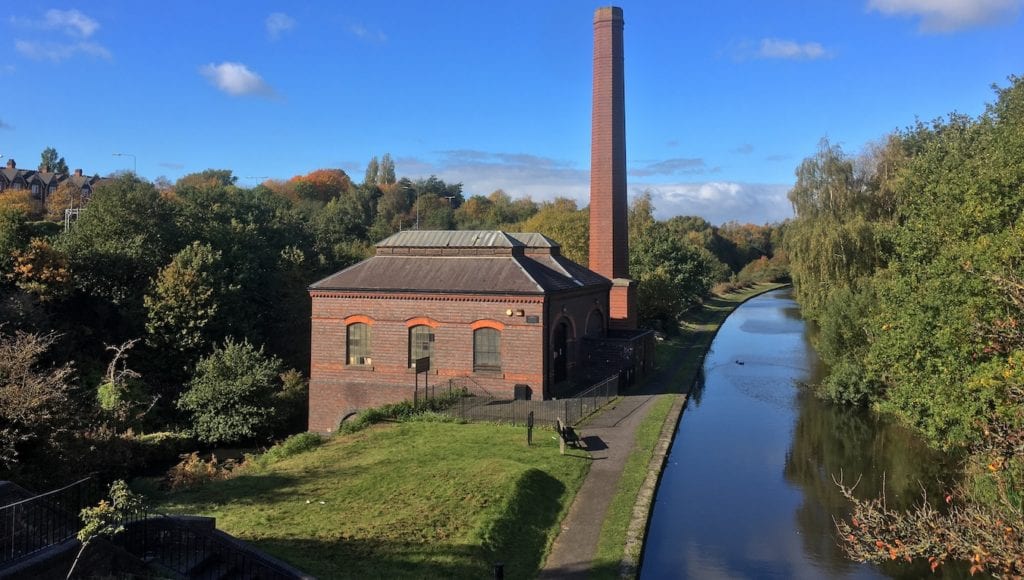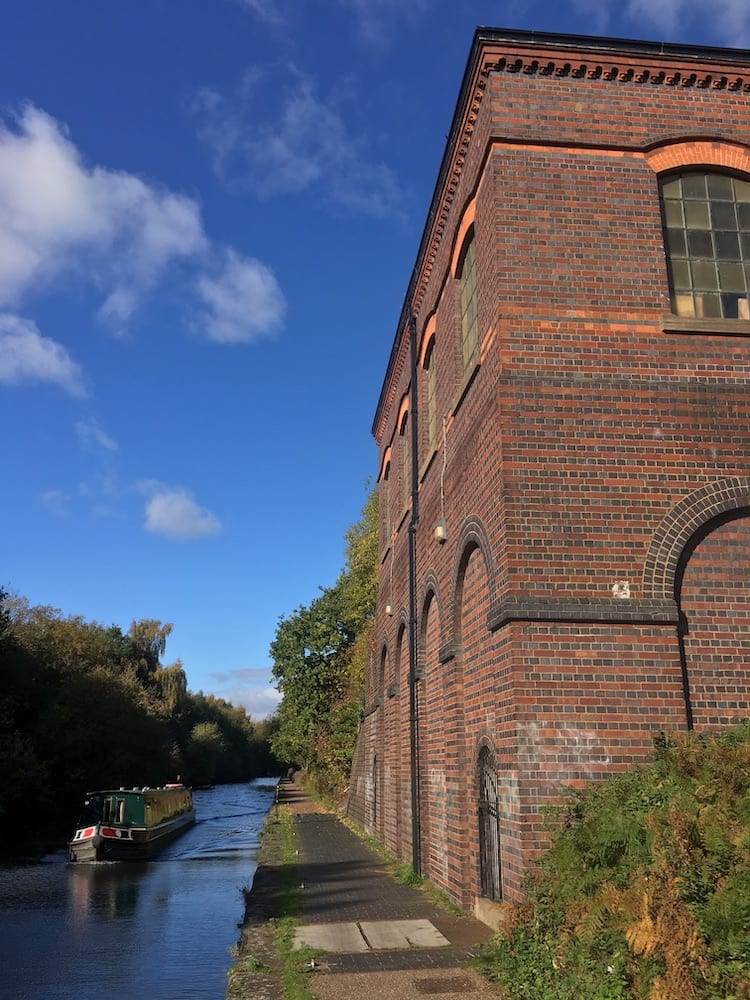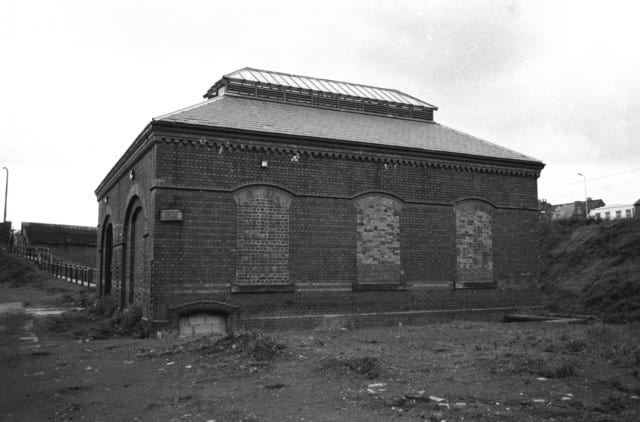Galton Valley Canal Heritage Centre
Galton Valley Canal Heritage Centre is the centrepiece of the Galton Valley Trail located in between the old and new Main Line canals of the Birmingham Canal Navigations. The centre is located inside the restored Galton Valley Pumping Station, also known as the ‘New Smethwick Pumping Station’ and was an important part of the system used to keep the canals working.


Tour guide available
Galton Valley Canal Heritage Centre is a key point of interest on our guided walk through the Galton Valley.
Key info
| Location | Brasshouse Ln, Smethwick, B66 1DS |
| County | West Midlands |
| Completed | 1892 |
| Engineer | G. R. Jebb |
| Maintained by | Sandwell Council |
| Heritage category | Listed Building Grade II |
Visiting guide
Check opening hours
Free entry
Free car park
When is Galton Valley Canal Heritage Centre open?
The centre is usually open on one Saturday per month between April and October from 10 am to 3 pm; however, it is best to check if it has temporary opening times due to the pandemic.
What can I expect when visiting Galton Valley Canal Heritage Centre?
This attraction is best enjoyed as part of the Galton Valley Trail. There are steps next to the chimney where you can walk up to the old main line above or down to the new main line below.
Each level offers varying views of the structure. Next to the steps is the ash hole, where ash from the boilers was deposited. Walk up the steps, turn right past the chimney and you will see a small door that leads to the coal hole.
The best view of the pumping station and Galton Valley can be enjoyed from the pedestrian bridge that crosses the adjacent railway. You can access this bridge from Brasshouse Lane. From this height, you can experience the sheer magnitude of Galton Valley and think about the countless men who dug it all out by hand!
Walk up Brasshouse Lane over the old main line canal and you will notice a grassy area on the left. Here, you can see a few monuments that pay homage to the history of the area.
How long does it take to see Galton Valley Canal Heritage Centre?
Seeing the centre from the outside will take around 20 minutes if you wish to take in the views from both canal levels and the pedestrian bridge. When the centre re-opens, we will visit and report how long the interior takes to enjoy.
How do I get to Galton Valley Canal Heritage Centre?
Smethwick Rolfe Street railway station is a very short walk from the centre. If you are travelling by car, use the car park on the corner of Great Arthur Street and Brasshouse Lane. There are no restrictions and it’s also a very short walk.
History of Galton Valley Pumping Station
Galton Valley is an artificial landscape that was created for the canals to pass through from Birmingham to the Black Country and beyond.
1769 – The original canal, completed by James Brindley, crossed over what used to be a hill via two flights of locks, one to raise it up to the summit, and the other to lower it down. When a boat passes through, water is drained down each flight of locks and must be replaced at the top for the cycle to work for additional traffic. The summit was supplied by a system of reservoirs; however, the unexpected popularity of the canal resulted in more traffic, which put pressure on what was already an inadequate water supply. This prompted the canal company to invest in a solution.
1777-1778 – Two Boulton & Watt steam engines were erected next to each flight of locks to pump water from the bottom back up to the summit. As the canal network started to expand, the appearance of new lines presented additional pressure on the water supply at Smethwick.
1790 – John Smeaton was hired to design a cutting, which essentially lowered the height of the hill and the canal by 18 ft (5.5 m). The cutting reduced the number of locks thus improving the efficiency of water usage and navigation time. This is the canal on the higher level next to Galton Valley Pumping Station.
1824-1829 – The canal was improved again by Thomas Telford. He constructed a wider and straighter line that reused parts of Brindley’s original route and bypassed the locks at Smethwick via a deeper cutting. This is the canal on the lower level next to Galton Valley Pumping Station.
1891 – Despite these improvements, the steam engine in the east (called the Smethick Engine) was still required to pump 160 lockfuls of water per day from the lower level back up to the summit. It faithfully accomplished this until this year when it was deemed irreparable by G. R. Jebb, the resident engineer at the canal company, which was now called the Birmingham Canal Navigations or BCN.
Jebb recommended a new pumping station be constructed at the heart of the Smethwick summit between the two canal levels. This new station was more powerful pumping 200 lockfuls of water per day using two vertical Z crank compound steam engines manufactured by Tangye Brothers at their Cornwall Works nearby. Each engine was fitted with Korting Bros injector condensers and drove 16-inch diameter centrifugal pumps using steam from their own Lancashire boiler [1].
1892 – The new station was designed by Jebb and started pumping in this year. The building was probably constructed by the BCN’s employees rather than a building contractor.
1905 – One of the engines was relocated to the Bentley Canal.
1920-1921 – The remaining engine was retired due to declining traffic. The boilers were removed the following year.
1930 – The remaining plant was sold for scrap before the building was declared void to relieve the BCN from paying rates. Afterwards, the chimney was demolished, and its debris dumped into the building’s ash pit [2].
Canal transport was in decline during the 1920s and 1930s due to the development of road haulage and the increasing use of gas to fire industrial engines and production [3]. Since gas can be transported much more efficiently through piping, the demand for coal dropped and so did traffic on the canal, a drop that it would never recover from.
1940 – Two diesel submarine engines were installed during the Second World War to pump water up to the old Main Line canal above, which was a designated supply of water to the Birmid factory in the event of a fire [1]. Birmid was a significant producer of castings and other components for the motor, aircraft, and general engineering industries [4]. This would have made the factory a target of the Axis; however, it was never attacked, and so the diesel engines were never unused.
1946 – All of the equipment was removed in 1946 and the building fell into disrepair.
Restoration
1978 – The pumping station is listed as a Grade II structure and it was in a pretty bad state.
1985 – The roof had been rebuilt as shown in this photo.

Gaining listed status set a path for restoration, which took 22 years. Firstly, a replacement engine was required and by potluck, a similar Tangye model was discovered and donated by Tyneside Metropolitan Borough Council.
1989 – A 30-tonne cast-iron cylindrical boiler was sourced from the nearby Rolfe Street Baths when it was taken down (the building was re-erected at the Black Country Living Museum in 1999).
1990 – The 83 ft chimney was rebuilt using traditional Staffordshire engineering bricks. The internal work was carried out by Dorothea Restorations.
2000 – The finishing touches were completed following a successful lottery bid [2].
The restoration of the Galton Valley Pumping Station is testament to the endless dedication given by so many enthusiasts over the years. The building can now be enjoyed by all and it is run to this day by volunteers.
Architecture
The pumping station is a brick structure with a hipped slate roof in two spans, with louvred ridge ventilators. The upper storey contains windows with segmental heads and a miniature false machicolation to the eaves. The lower storey features a blind arcade with impost bands. The north-east wall, facing the upper level, has two wide elliptical arches with smaller inner segmental arches. The right-hand arch is blocked, the left-hand one is the main doorway [5].
Sources
- Sandwell Metropolitan Borough Council & Galton Valley Canal Heritage Centre – Information Board
- Davies, R. H. (2010) The Birmingham Canal Navigations Through Time. Stroud: Amberley Publishing Plc.
- Chitham, E. (2009) West Bromwich: A History. Chichester: Phillimore & Co Ltd.
- (1938) ‘Birmid Industries Further Expansion in Turnover’, The Scotsman, 2 December, p. 4.
- Historic England (2020) Smethwick New Pumping House Approximately 50 Metres North West of Brasshouse Lane Birmingham Canal Birmingham Level. Available at: https://historicengland.org.uk/listing/the-list/list-entry/1077154 (Accessed: 12 December 2020).


 Galton Valley Trail
Galton Valley Trail